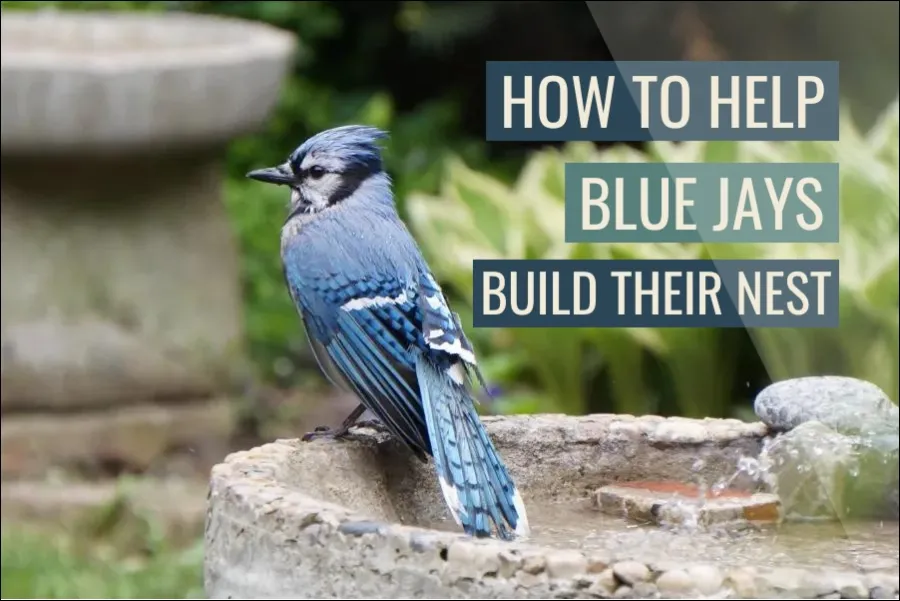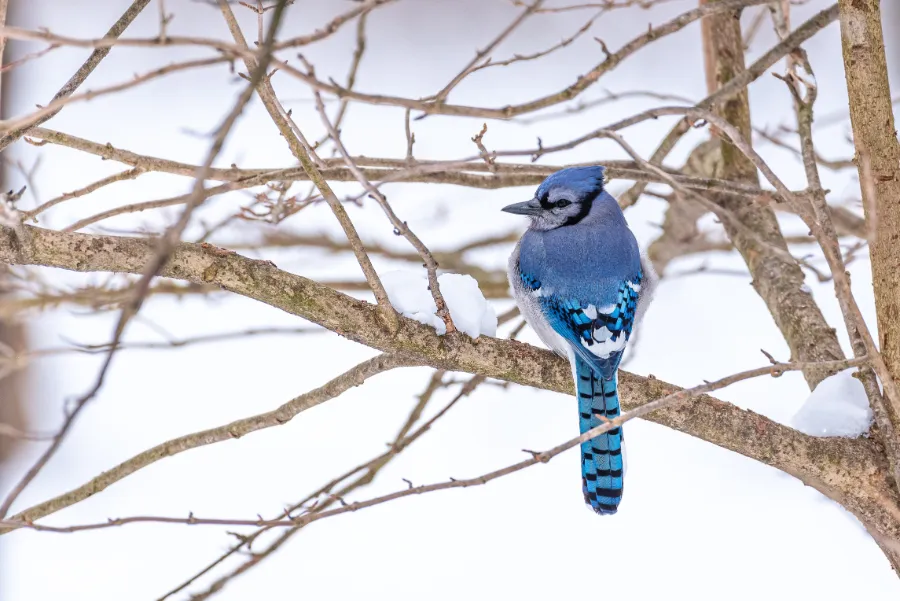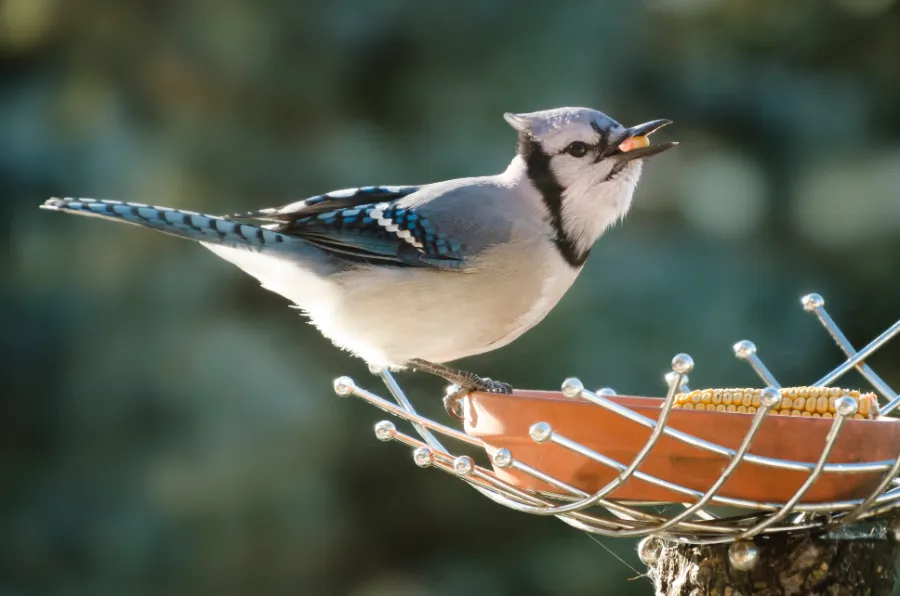
Blue jays are intelligent and industrious birds that are a common sight in many backyard gardens. These striking birds are known for their distinctive blue and white plumage, as well as their energetic personalities and bold behavior.
To help blue jays build their nests, provide materials and create a safe environment. Attract them with food and water, and they’ll contribute to the health of your local ecosystem. Enjoy the beauty and energy of these birds while helping the environment.
If you’re interested in attracting blue jays to your yard and helping them build their nest, there are several steps you can take to create a welcoming environment and provide the resources they need. In this article, we’ll explore how to help blue jays build their nest and provide tips for creating a blue jay-friendly backyard.
The importance of blue jays in the ecosystem
Blue jays are vital elements of the ecosystem, functioning as markers of forest health and aiding in the dispersal of many plant species’ seeds. You may benefit the general health and variety of your local ecosystem by attracting blue jays to your yard and assisting them in building their nests.
The process of blue jay nest-building
Blue jays are expert nest builders, constructing their nests out of a range of materials such as twigs, grasses, moss, and mud. They usually make their nests in trees, although they may sometimes use structures like buildings or utility poles.
Choosing the right location for a blue jay nest
When deciding where to build a blue jay nest, consider the availability of building materials, the presence of predators, and the accessibility to food and water supplies. Blue jays prefer to nest in trees, although they may sometimes use other structures such as buildings or utility poles.
Providing materials for blue jays to build their nest
You may assist blue jays in building their nest by giving them with twigs, grasses, moss, and mud. You may also build a “nest box” by erecting a birdhouse or other building particularly intended to attract blue jays.
Creating a safe and welcoming environment for blue jays
In addition to providing nesting materials, you may make a safe and welcome habitat for blue jays by eliminating predators and other risks. This might involve keeping cats, dogs, and other possible predators out of your yard, as well as avoiding the use of pesticides or chemicals that are detrimental to blue jays.

Attracting blue jays to your yard with food and water
Blue jays are drawn to a wide variety of items, such as seeds, nuts, fruit, and insects. Blue jays can be attracted to your yard by providing a consistent food supply, such as a seed-filled bird feeder or a fruit-bearing tree or bush. Blue jays require clean water for drinking and bathing in addition to eating.
Protecting blue jays and their nests from predators
Blue jays are prey to predators such as cats, dogs, and some bird species. You may help safeguard blue jays and their nests from predators by erecting protective barriers around the nest, eliminating potential predator hiding areas, and keeping pets under control.
The role of pesticides and chemicals in blue jay health
Pesticides and pesticides can be toxic to blue jays and other animals, affecting their health. You may make your yard a safer place for blue jays and other wildlife by avoiding the use of these pesticides.
How to monitor and observe blue jays without disturbing them
If you want to observe blue jays in your yard, you must do it in a method that does not upset the birds or interfere with their behavior. This can entail using binoculars or a spotting scope to see the birds from a distance, as well as constructing a birdhouse or nest box with a window or camera for up-close watching.
The benefits of attracting blue jays to your yard
Attracting blue jays to your yard may have a variety of advantages for both the birds and you. Aside from the thrill and satisfaction of observing these beautiful and lively birds, attracting blue jays may help increase the health and variety of your local ecology, as well as decrease insect populations.
Where do blue jays lay their eggs?
Blue jays lay their eggs in nests that they construct in trees or other structures. These nests are often built of twigs, grasses, moss, and other materials, with softer materials such as feathers or fine grasses lining them. Blue jay nests are often built in the fork of a tree limb or in a cavity, such as a hole in a tree or a nest box. Blue jays may also use other structures as nesting locations, such as buildings or utility poles. Once the nest is constructed, the female blue jay will deposit her eggs, usually one or two each day, until the entire clutch is laid. The female incubates the eggs, while the male feeds the female and the chicks as they hatch.

Do blue jays come back to the same nest?
Blue jays may return to the same nest in consecutive mating seasons, however this behavior is unknown and may vary from individual to individual. Some blue jays return to the same nest location year after year, while others build a new nest or utilize a different nest site each year. The availability of good nest locations, the effectiveness of past breeding attempts, and the presence of predators or other hazards are all factors that may affect a blue jay’s decision to reuse a nest. It is also feasible that blue jays will reuse the same nest location with other blue jay pairs, establishing a cooperative breeding community. Overall, blue jay nest reuse behavior is complicated and little understood, and further study is needed to identify the elements that impact this activity.
What do blue jays use to build their nests?
Blue jays make their nests out of a range of materials, including twigs, grasses, moss, mud, and other items. They might harvest these items from the ground or from adjacent plants and trees. Blue jays are adept nest builders, spending many days or even weeks meticulously arranging and weaving the materials together to produce a solid and well-insulated construction. To provide warmth and comfort for the eggs and chicks, the inside of the nest is typically lined with softer materials such as feathers or fine grasses. Other materials, such as fragments of paper, rope, or other trash, may be included into blue jay nests. Overall, the precise materials used by blue jays to build their nests may vary based on resource availability and the local environment.
What month do Blue Jays lay eggs?
In most regions of the United States, blue jays lay their eggs between April and May, however this might vary depending on the exact location and weather circumstances. Blue jays are normally monogamous and will mate for life, with the male and female building the nest and raising the babies together. The female blue jay will lay one or two eggs every day until the entire clutch is laid, which can range between two and seven eggs depending on the particular bird. The female will incubate the eggs for roughly 17 to 18 days after they are laid, while the male will provide food to the mother and the chicks once they hatch. Both parents feed the chicks, and they will fledge (leave the nest) in three to four weeks.
What is a Blue Jays favorite food?
Blue jays are omnivore birds, which means they eat a wide variety of foods. Blue jays eat a range of seeds, nuts, fruits, and insects in the wild. They are known to be especially fond of acorns and will frequently store them for later use. Insects such as beetles, grasshoppers, and caterpillars are also eaten. Blue jays may be drawn to bird feeders in residential areas and will consume a variety of seeds and nuts given by humans. Blue jays save food for the winter as well.

Where do Blue Jays nest in winter?
Blue jays are indigenous to North America and may be found over the majority of the continent, including the United States, Canada, and Mexico. They are non-migratory birds, which means they do not travel large distances to escape the cold conditions. During the colder months, they may migrate to lower altitudes or more protected locations in search of food and refuge. Blue jays normally build their nests in trees, making use of a range of materials such as sticks, twigs, grasses, and moss to create a safe and pleasant home. Blue jays may roost in their nests throughout the winter, or they may seek for other protected sites like as holes in trees or buildings.
Do Blue Jays nest in the same place every year?
It is not uncommon for blue jays to return to the same general area to nest each year, but they do not typically reuse the same nest year after year. After breeding season is over, blue jays will often abandon their nests and may not return to them again. Instead, they will build a new nest in a different location for the next breeding season. In some cases, blue jays may reuse a nest that was built by another species, but this is relatively rare. It is not clear why blue jays do not reuse their own nests, but it is thought that this behavior may help to reduce the risk of parasites or disease.
How many broods do Blue Jays have?
Blue jays normally have one or two broods every year, but in extreme circumstances, three. The female blue jay constructs the nest and incubates the eggs, while the male brings food to the female and assists in the feeding of the chicks once they hatch. The female deposits a clutch of 4-6 eggs, which hatch after around 17-18 days of incubation. Both parents contribute to the feeding and caring of the chicks, and the young blue jays fledge (leave the nest) 3-4 weeks after hatching. Following the emergence of the young birds, the parents may begin the process of constructing a new nest and raising another brood. In rare situations, the first brood’s young may assist in the caring of the second brood’s chicks.
When do baby Blue Jays leave the nest?
Blue jay chicks, also known as fledglings, normally leave the nest when they are 3-4 weeks old. This is referred to as fledging. The chicks are completely reliant on their parents for food, warmth, and safety during their first few weeks of life. They are altricial, which means they are born without feathers and cannot move or control their body temperature. The chicks gain feathers and become more mobile as they mature. The chicks are completely feathered and able to fly short distances by the time they fledge. After fledging, the chicks are still reliant on their parents for a while, and the adults will feed and care for them until they are ready to fend for themselves.
In conclusion
Overall, this article has given an overview of how to assist blue jays in building their nests and creating a blue jay-friendly backyard. You may help guarantee that blue jays have the resources they need to flourish and contribute to the health of your local environment by following these instructions. Attracting blue jays to your yard may have a lot of good effects on the environment and the community, in addition to offering a source of delight and beauty.
